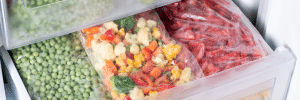Is your refrigerator stuffed with more irresistible local summer produce than you can eat in a week? Don’t let all that great local nutrition and flavor go to waste!
Seasonal Roots’ small family farmers work hard to serve you fruits and vegetables picked at the peak of ripeness, and you deserve to enjoy it at its healthful, tasty best. But what if you wind up with too much and can’t eat it during that window when it’s super fresh?
The solution is easy: Freeze it. Fresh produce will keep in the freezer for 8-12 months! Or, if you’re feeling ambitious, you can can it. While refrigeration slows down that ticking clock of deterioration, freezing and canning both stop it cold. The nutrients and flavor stay put until you’re good and ready to eat it.

Freezing requires no special gear, and it’s quick and easy. We’re all for quick and easy, so we’re going to focus on freezing here.
-
-
- To save fresh local produce, start with produce that’s as fresh as possible and in good condition. Don’t wait until it’s wilting and turning yellow.
- Clean it thoroughly. For things like tender herbs, greens, berries, and peaches, you can skip to #6.
- For things like zucchini, beans, carrots, and other root veggies, boil water and either drop the produce directly into the water or steam it. Whether boiling or steaming, do this for 2-5 minutes until they’re just done.
- From there, drop the produce into ice water. This process, called “blanching”, stops the enzyme activity that destroys nutrients and changes texture.
- Let the produce cool, then put it into plastic freezer bags, squeezing out the air as you seal it up.
- Or, to keep all that produce from freezing into one big solid unwieldy block, pat it dry, spread it out in a single layer on a cookie sheet, and place the cookie sheet in the freezer. Once the individual pieces are frozen, pop them into bags. When you’re ready to use them, you can pull out a handful if that’s all you need.
- Pro tip: WRITE THE CONTENTS ON THE BAG. Nothing like pulling out a six-month-old frosty bag of… something or other.
-
Follow these steps and the end of summer won’t mean the end of smoothies, pies, soups, and stews made with fresh local summer produce. Freezing makes it possible for you to enjoy delicious, nutritious meals that still have the taste of summer in the off-season. Bonus!
It’s true that heat does cause nutrient loss, and both freezing and canning expose the produce to heat. But in most cases, you don’t lose any more than you would from cooking.
And if you freeze it promptly before those nutrients have a chance to slip away, you’ll generally lose less. Certainly less than you would if you let it sit in the fridge for a couple weeks, even if you ate it uncooked at that point.
For a deeper dive, here’s an article from the University of California at Davis, that compares how much nutritional value is lost during refrigerated storage and cooking versus freezing and canning.
Here’s a more detailed how-to on freezing from Mother Earth News.
And to REALLY get down in the weeds, the National Center for Home Food Preservation lets you look up how to freeze almost anything.
About Seasonal Roots
Since 2011, Seasonal Roots’ online farmers market has connected Virginia families with local family farmers who use sustainable, humane practices. Our neighborhood market managers – who believe in living better through scrumptious, healthy eating, being kind to animals, protecting the environment, and spreading joy – home-deliver freshly harvested produce, pastured eggs, grass fed dairy and meat, plus artisan fare. We empower our members to eat better and live better with more nutritious, flavorful food that’s good for us and good for the planet. More info at seasonalroots.com.